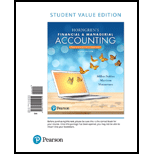
Concept explainers
1.
Perpetual Inventory System refers to the inventory system that maintains the detailed records of every inventory transactions related to purchases and sales on a continuous basis. It shows the exact on-hand-inventory at any point of time.
In First-in-First-Out method, the cost of initial purchased items are sold first. The value of the ending inventory consists the recent purchased items.
In Last-in-First-Out method, the cost of last purchased items are sold first. The value of the closing stock consists the initial purchased items.
In Average Cost Method the cost of inventory is priced at the average rate of the goods available for sale. Following is the mathematical representation:
To Prepare: The perpetual inventory record for the merchandise inventory using the FIFO inventory costing method.
2.
To Prepare: The perpetual inventory record for the merchandise inventory using the LIFO inventory costing method.
3.
To Prepare: The perpetual inventory record for the merchandise inventory using the weighted average inventory costing method.
4.
The Company’s cost of goods sold for January using FIFO, LIFO, and weighted-average inventory costing methods.
5.
To Compute: The gross profit for January using FIFO, LIFO, and weighted-average inventory costing method.
6.
To Explain: The method that the company should use to maximize gross profit.
Want to see the full answer?
Check out a sample textbook solution
Chapter 6 Solutions
Horngren's Financial & Managerial Accounting, The Financial Chapters, Student Value Edition (6th Edition)

 AccountingAccountingISBN:9781337272094Author:WARREN, Carl S., Reeve, James M., Duchac, Jonathan E.Publisher:Cengage Learning,
AccountingAccountingISBN:9781337272094Author:WARREN, Carl S., Reeve, James M., Duchac, Jonathan E.Publisher:Cengage Learning, Accounting Information SystemsAccountingISBN:9781337619202Author:Hall, James A.Publisher:Cengage Learning,
Accounting Information SystemsAccountingISBN:9781337619202Author:Hall, James A.Publisher:Cengage Learning, Horngren's Cost Accounting: A Managerial Emphasis...AccountingISBN:9780134475585Author:Srikant M. Datar, Madhav V. RajanPublisher:PEARSON
Horngren's Cost Accounting: A Managerial Emphasis...AccountingISBN:9780134475585Author:Srikant M. Datar, Madhav V. RajanPublisher:PEARSON Intermediate AccountingAccountingISBN:9781259722660Author:J. David Spiceland, Mark W. Nelson, Wayne M ThomasPublisher:McGraw-Hill Education
Intermediate AccountingAccountingISBN:9781259722660Author:J. David Spiceland, Mark W. Nelson, Wayne M ThomasPublisher:McGraw-Hill Education Financial and Managerial AccountingAccountingISBN:9781259726705Author:John J Wild, Ken W. Shaw, Barbara Chiappetta Fundamental Accounting PrinciplesPublisher:McGraw-Hill Education
Financial and Managerial AccountingAccountingISBN:9781259726705Author:John J Wild, Ken W. Shaw, Barbara Chiappetta Fundamental Accounting PrinciplesPublisher:McGraw-Hill Education





